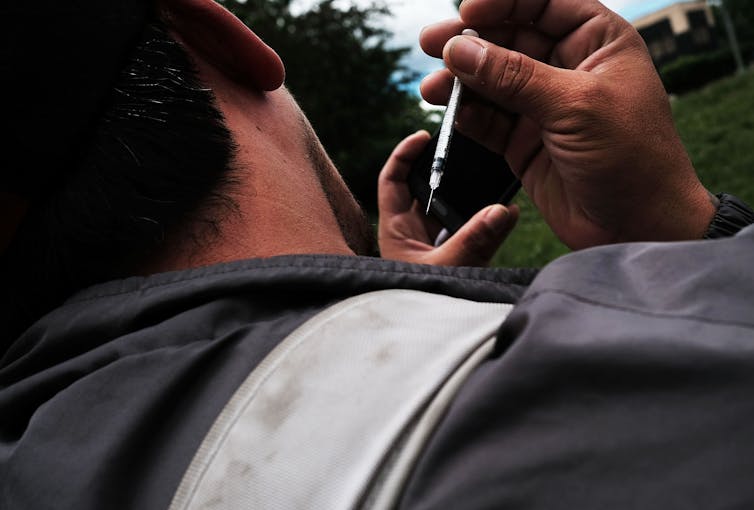Offering treatment to drug users instead of arresting them reduces crime and addiction – new research into police diversion program shows
By Josephine Korchmaros, University of Arizona
When police get suspected drug abusers treatment rather than arresting them, those people are less likely to abuse drugs or commit drug-related crimes in the future, new, limited research finds. This kind of police intervention can help reduce opioid abuse.
The U.S. has been in the throes of rampant opioid abuse since the late 1990s. Communities around the country have experienced increases in opioid-related deaths and crimes as a result.
One study shows opioid-related deaths more than quadrupled from 9,489 in 2001 to 42,245 in 2016. Another study indicates that people addicted to opioids are more likely than people who don’t use opioids to have run-ins with police. The rate of opioid-related crimes in the U.S. has increased substantially, from 32 per 100,000 people in 2005 to 78 per 100,000 people in 2018.
Historically, for public safety, police have arrested people suspected of using drugs. Research shows, though, that this approach has not been effective at reducing drug abuse or related crimes.
But there is another way that appears to work better. In Arizona, the Tucson Police Department is trying an approach known as pre-arrest diversion. When officers respond to community calls about crime, they sometimes suspect the perpetrator may be abusing drugs. When they do, they don’t always arrest that person. Instead, officers connect that person with substance abuse treatment providers. I recently led a study that found this approach is as effective as arrest at reducing both drug abuse and crime.
As a professor of social and behavioral sciences, I study treatment models and policy improvement regarding substance use and the criminal justice system. Following a community-based approach, I share the findings with other researchers and policymakers, as well as with the groups I studied.

The shift in policing
Before 2011, most police departments in the U.S. typically arrested people for drug abuse without giving them an option for substance abuse treatment.
Seattle’s Law Enforcement Assisted Diversion program, which was launched in 2011, is the first known pre-arrest diversion program in the country. Seattle police worked with behavioral health providers, court officials and community groups to set up the program, commonly referred to as LEAD.
LEAD focuses on addressing crime and community safety issues related to drug abuse. The program also focuses on reducing problems such as difficulty finding a job when a person has a criminal record.
In 2015, the Police Assisted Addiction and Recovery Initiative grew out of Gloucester, Massachusetts’ policy to send people who use drugs to substance abuse treatment instead of arresting them. The initiative has helped nearly 600 police departments, including Tucson’s, across 34 states to put in place similar drug- and opioid-abuse diversion programs.
In Tucson, instead of arresting people for illicit drug use or related crimes such as trespassing, officers may encourage those people to enroll in substance abuse treatment and give them rides to treatment providers. In addition to evidence-based substance abuse treatment, such as providing medication that treats withdrawal symptoms, the providers offer other health care services, mental health treatment and other support.
The department rolled out the program in July 2018. That year, Pima County, where Tucson is located, had 175 fatal opioid overdoses and an increase in property crime due to substance and opioid abuse, and there were 1,116 opioid overdose deaths statewide in Arizona.
My research shows that 2,129 times in a three-year period, officers sent people to substance abuse treatment instead of arresting them. And officers gave people rides to treatment 965 times. The data I analyzed also shows this approach takes 25 minutes less time, per incident, on average, than arresting people.
Programs like these represent a shift from arrest and criminalization of people who abuse drugs toward a police response that focuses on longer-term reduction of drug abuse.

The effectiveness of pre-arrest diversion programs
Findings from research on the effectiveness of Seattle’s pre-arrest diversion program suggest that these criminal diversion programs result in fewer arrests for people with substance abuse disorders. The findings also indicate that the program decreased homelessness, another program goal, with participants twice as likely to have housing after participating.
My team’s research shows that people who were offered substance abuse treatment, instead of being arrested, decreased their drug use more than people who were not offered substance abuse treatment and were arrested. On average, six months after their interaction with Tucson police, people who accepted diversion to a substance abuse treatment program used illegal drugs less frequently than people who had been arrested.
In addition, diversion to substance abuse treatment in Tucson was as effective as arrest in decreasing criminal activity.
That is why these programs may be an effective way to address the opioid epidemic.
 People mourn loved ones who have died from drug overdoses before replica tombstones in Binghamton, N.Y., on Aug. 19, 2023. Andrew Lichtenstein/Corbis via Getty Images
People mourn loved ones who have died from drug overdoses before replica tombstones in Binghamton, N.Y., on Aug. 19, 2023. Andrew Lichtenstein/Corbis via Getty Images
![]()
Josephine Korchmaros, Professor of Social and Behavioral Sciences, University of Arizona
This article is republished from The Conversation under a Creative Commons license. Read the original article.



